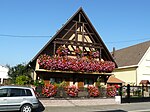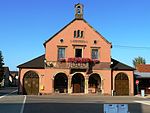Mussig
Bas-Rhin geography stubsCommunes of Bas-Rhin

Mussig is a commune in the Bas-Rhin department in Alsace in north-eastern France. Successive known names carried by the village were: Moussich, Mosich (1370) and Musich (1453) before becoming Musselburgh. The etymological origin is probably to be found in the existence of wetlands and swamps are conducive to the formation of foam. Until the 19th century was practiced widely growing flax and hemp, woven at home or delivered to the weavers in the valley of Sainte-Marie-aux-Mines, this is still in the early twentieth century.
Excerpt from the Wikipedia article Mussig (License: CC BY-SA 3.0, Authors, Images).Mussig
Rue des Jardins, Sélestat-Erstein
Geographical coordinates (GPS) Address Nearby Places Show on map
Geographical coordinates (GPS)
| Latitude | Longitude |
|---|---|
| N 48.2294 ° | E 7.5208 ° |
Address
Rue des Jardins 1
67600 Sélestat-Erstein
Grand Est, France
Open on Google Maps










